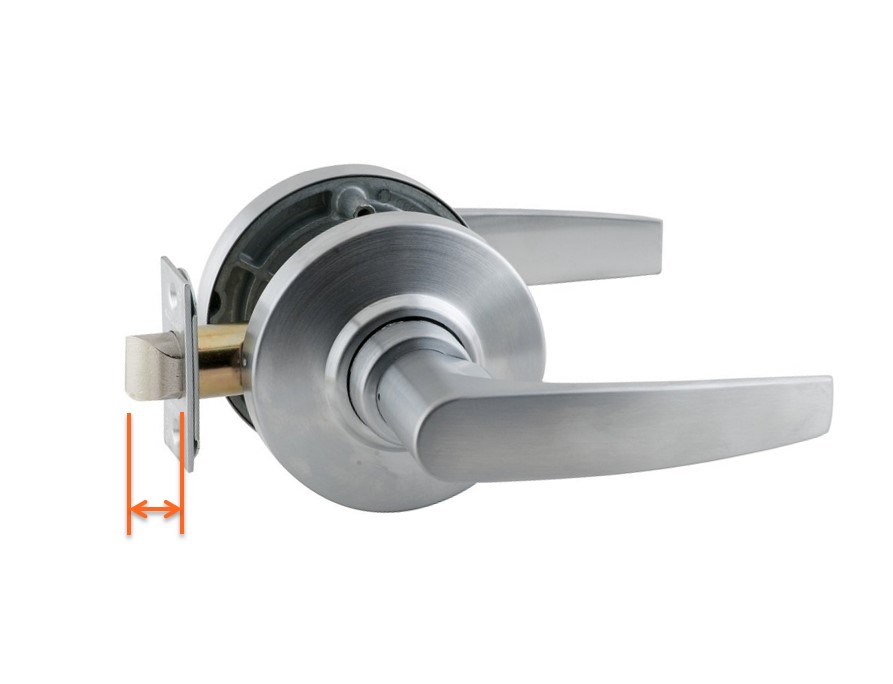In order for a fire door assembly to perform as designed and tested, it’s critical for the door to be closed and latched if/when a fire occurs. Each fire door must be equipped with an active latchbolt to keep the door latched under pressure created by a fire, and most doors in a means of egress are required to unlatch with one releasing motion.
There are quite a few considerations with regard to fire-door latching, so here’s a quick run-down with links to additional information if you need it:
 Latch Throw – Recent editions of NFPA 80 no longer state the required latch throw – the distance that the latch must project from the door edge. However, the minimum latch throw is stated in the door manufacturer’s listings, and must be included on the fire door label. A typical minimum latch throw is between 1/2-inch and 3/4-inch, depending on the listings.
Latch Throw – Recent editions of NFPA 80 no longer state the required latch throw – the distance that the latch must project from the door edge. However, the minimum latch throw is stated in the door manufacturer’s listings, and must be included on the fire door label. A typical minimum latch throw is between 1/2-inch and 3/4-inch, depending on the listings.
Label – Components used as part of a fire door assembly must be listed and labeled for that purpose. Swinging fire door assemblies are typically tested for compliance with UL 10C or NFPA 252 with the neutral pressure plane located 40 inches above the floor at 5 minutes into the test. Labeled latching hardware is one of the items that is verified during a fire door assembly inspection.
Deadbolt – Where deadbolts meet the egress and accessibility requirements of the applicable model codes, they can be installed on fire door assemblies as long as they are listed and labeled for that purpose. Deadbolts that are part of a mortise lock or interconnected lock, and which retract for egress with one operation of the lever handle, are typically acceptable. Separate deadbolts, which would require an additional releasing operation (along with using the lever to retract the latchbolt), are allowed for dwelling units and sleeping units, but are not allowed in most other applications.
Fire Exit Hardware – When panic hardware is used on fire door assemblies, it must be fire exit hardware, which is listed for both panic (UL 305) and fire (UL 10C / NFPA 252). This hardware can not incorporate the mechanical dogging feature, which would allow the latch to be held back and could leave the door unlatched during a fire. Fire doors with fire exit hardware must have a label stating that the door is to be equipped with fire exit hardware; this ensures that the door is properly reinforced for the hardware. The hardware will also have a label stating the listings, manufacturer, and serial number. Open-back strikes can be used with fire exit hardware when this application is permitted by the manufacturer’s listings.
Less Bottom Rod / Cable – For pairs of doors, fire exit hardware may be provided without the bottom rods/cables, bottom latches, and floor strikes. With this application, there are no bottom rods and latches to be damaged by cart traffic or to interrupt the flush area at the bottom of the door (as required by the accessibility standards), and no need for strikes in the floor. When the bottom rods and latches are omitted, most door and hardware listings require an auxiliary fire pin, which will project and keep the doors aligned during a fire. Because the pin only projects when a high temperature is reached, it does not present an egress problem and this type of hardware is allowed by the model codes.
Electric Latch Retraction – NFPA 80 allows latching devices which do not latch in the normal mode, as long as the door automatically becomes positively latched in a fire emergency. This latching must be actuated by an automatic fail-safe device activated by an automatic fire detector. Electric latch retraction / electric dogging can be used on fire doors as long as the door becomes latched when the fire alarm is activated.
Electric Strike – If an electric strike is used on a fire door assembly, it must be a fail-secure strike which will remain positively latched upon power failure. Fail-safe electric strikes are not listed for use on fire doors. Because an electric strike keeper could be left unlatched by the access control system, it should interface with the fire alarm system in order to ensure that the door will be positively latched during a fire.
Stairwell Doors – To allow building occupants to leave a stair if it becomes compromised by smoke, the IBC requires most stair doors to either allow free access from the stair to each floor, or the capability of unlocking the stair side via the fire command center (NFPA 101’s requirements are slightly different). When the door is remotely unlocked, it must remain latched. This set of requirements is described as “stairwell reentry.” Doors leading to exit enclosures (stairs and exit passageways) are typically fire-rated, so a fail-safe electric strike can not be used to accomplish stairwell reentry. A fail-safe lock or fail-safe fire exit hardware may be used.
Inactive Leaf – The requirement for positive-latching extends to the inactive leaf of most fire-rated pairs of doors. This can be accomplished with fire exit hardware, 2-point latches, or automatic flush bolts (including constant-latching flush bolts). Manual flush bolts or surface bolts may be installed where acceptable to the AHJ as long as they do not pose a hazard to life safety. Annex A of NFPA 80 limits this application to rooms that are not normally occupied by people, such as a boiler room or mechanical room. Note that NFPA 101 requires corridor doors in health care occupancies – even non-fire-rated corridor doors – to have positive-latching hardware, so manual flush bolts can not be used in that application.
Coordinator – Hardware installed on some pairs of doors will require one leaf to close before the other in order for both doors to latch properly. For these applications – usually pairs with automatic flush bolts and/or an astragal – a coordinator is required to ensure that the door leaves close in proper sequence (this video includes more information about flush bolts and coordinators, and here is a video showing a coordinator in operation).
Fasteners – NFPA 80 requires locks, latches, flush bolts, and fire exit hardware to be secured to reinforcements in the doors with machine screws or through-bolts. The standard requires pilot holes to be drilled, and specifies that hardware installed on wood doors must use fasteners that are not less than No. 8, fat, threaded-to-the-head wood screws or through-bolts. Fire exit hardware must be attached to wood fire doors with through-bolts or steel screws, and strike plates for latches must be secured to the frame with steel screws or as indicated by the manufacturer’s listings. Manufacturers’ installation instructions may include additional requirements; typically these products must be installed using the fasteners that were provided with the hardware.
Alterations – When existing fire door assemblies are modified in the field, NFPA 80 specifies whether the work is considered a job-site preparation or a field modification. The standard includes requirements for each type of alteration, limiting most job-site preparations to 1-inch-diameter round holes, and establishing a process for pre-approval of field modifications that are beyond what is allowed as a job-site preparation. When hardware is removed, NFPA 80 also specifies how existing fastener holes may be filled.
For more information on fire doors, refer to iDigHardware.com/firedoor, or take the online Decoded training – Session #2 addresses fire door assemblies.
You need to login or register to bookmark/favorite this content.





Hi Lori,
A quick skim through your document and the section on electric strikes caught my eye. it reads: “An electric strike used on a fire rated assembly must be fail secure.” While this is true, the electric strike must also be fire rated. Door hardware including electric strikes is constructed from various base metals; brass, bronze, aluminum, pot metal, etc. Nonferrous metals will deform and melt at high heat temperatures. Fire rated strike are constructed from steel or stainless steel. Heavier duty strikes constructed from steel or stainless are often also fire rated. They are also more likely to be used where fail-secure is needed for reasons other than to be compliant with the rated assembly.
Nicely done Lori.
After a recent Joint Commission inspection, we were told by a Joint Commision inspector that the most common door failures noticed in Join Commision inspections are 1) non-latching doors. 2) non locking doors. The non-latching is often a problem when they have added smoke seals to control air movement. Retrofitted smoke seals and door latching is rarely a match made in heaven.
Lori, you mention fail secure electric strike on a rated door, but I don’t think that it’s permitted on a stair door. It would violate the stair re-entry requirement. We only permit this option on rated doors that are not stair doors.
Hi Tod –
Yes, exactly. 🙂 Electric strikes installed on fire doors must be fail-secure. Stair doors that require re-entry require a fail-safe product that remains latched when it is unlocked, so electric strikes can’t be used for that application.
– Lori
Hi Lori.
What is the typical manufacturers’required latch throw into the strike for a vertical rod, fire exit device?
Both top and bottom. Thanks
Hi Chuck –
I’m not sure what the latch throw is, but the templates show the required clearance at the top and bottom.
– Lori
Hi Lori.
If the manufactures instructions specify the clearances then the bolt penetration into the strike pocket should be pre-determined like a regular lockset.
Thanks again. You are always a big help.
The clearances stated in manufacturer’s instructions always references minimum clearance when setting the height of a bottom flush bolt (typically 1/8″ less than), but what people fail to realize is that minimum clearance isn’t necessarily at the latching point. It’s very rare that a floor is level across a 6′ span, and with any luck, the high point will be where it latches, but often times the high point of the floor could be when it’s open to 90°, or even 180°. It’s not uncommon for a floor to rise 3/8″ or more in those spans, which means the bottom flush bolt will start off that much higher. The code simply requires latching. I have a couple of coworkers who recently went through the DHI FDAI classes and they’re still pushing the minimum 1/2″ penetration thing, and from what I can tell, it’s incorrect. Add at least one bevel on a pair of doors and the likelihood is even less. Anyone who has installed for any period of time will tell you that 1/2″ penetration on a flush bolt is almost impossible-and always improbable.
Do you know a vendor in New York who can I stalk the doors in a new Health center article28!
Hi Lori,
Can you apply both Vertical exit device on Fire rated double door without horizontal latching?
Hi Roderick –
When you say “horizontal latching”, are you referring to the auxiliary fire pin with a less-bottom-rod device? If yes, the need for this pin may depend on the listings of the doors and the fire exit hardware. As far as I know, Von Duprin requires the pin for all LBR applications. If this is not what you’re asking about, send me an email at lori.greene@allegion.com.
– Lori
Recently ran across set of double doors to electrical closet with manual flush bolts on inactive leaf and manual deadbolt on active leaf. No closers on either. I know there is an exception for manual flush bolts but is there any circumstance where deadbolt without supplemental positive latching is allowed on closet door that is typically locked?
Hi Roman –
Are the doors in a location that requires a fire door assembly? If yes, I don’t know of an exception that would allow the deadbolt without positive-latching hardware.
– Lori
Lori,
I have a MDU using XE360 for fire rated stairwell. Allegion reommmend this but have concern on the “reentry” . How can I achieve this . With this lock . Only fail safe I see is battery die it opens.
Hi Darren –
The current version of this product does not have a fire alarm input, so it would not be an option for interior stairwell doors that have to allow reentry upon fire alarm activation. But it could be used for the stair discharge door, for example – the door that swings from the stairwell to the lobby or to the exterior.
– Lori